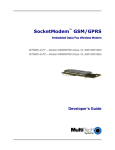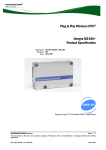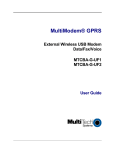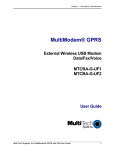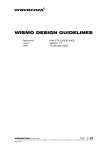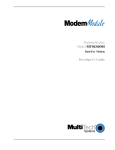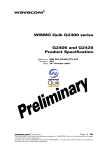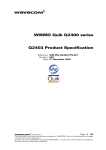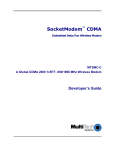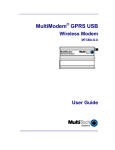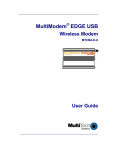Download Multitech MTSMC-G-F1 Specifications
Transcript
ModemModule GSM/GPRS Embedded Data/Fax/Voice Wireless Modem MTMMC-G-F1 MTMMC-G-F2 Developer’s Guide ModemModule GSM/GPRS Developer’s Guide MTMMC-G-F1 and MTMMC-G-F2 PN S000295E, Version E 03/30/04 Copyright This publication may not be reproduced, in whole or in part, without prior expressed written permission from Multi-Tech Systems, Inc. All rights reserved. Copyright © 2004, by Multi-Tech Systems, Inc. Multi-Tech Systems, Inc. makes no representations or warranties with respect to the contents hereof and specifically disclaims any implied warranties of merchantability or fitness for any particular purpose. Furthermore, Multi-Tech Systems, Inc. reserves the right to revise this publication and to make changes from time to time in the content hereof without obligation of Multi-Tech Systems, Inc. to notify any person or organization of such revisions or changes. Revisions Revision Level A B C D E Date 07/15/03 09/24/03 10/17/03 01/17/04 03/30/04 Description First release. Minor editorial comments and updated dimension drawing. Update mechanical dimension drawing. Incorporate edits, new Serial Test Developer’s Board drawing, remove GSM compliance table, update FTA compliance info. Revise feature description and miscellaneous specs & regulatory info. Patents This device is covered by patent number 5,673,268. Trademarks Trademarks of Multi-Tech Systems, Inc. are ModemModule and the Multi-Tech logo. MNP and Microcom Network Protocol are registered trademarks of Microcom, Inc. Microsoft, Windows, Windows 95, and Windows NT are either registered trademarks or trademarks of Microsoft Corporation in the United States and/or other countries. World Headquarters Multi-Tech Systems, Inc. 2205 Woodale Drive Mounds View, Minnesota 55112 Phone: 763-785-3500 or 800-328-9717 Fax: 763-785-9874 Technical Support Country By Email By Phone France: India: U.K.: U.S. and Canada: Rest of the World: [email protected] [email protected] [email protected] [email protected] [email protected] (33) 1-64 61 09 81 91 (124) 6340778 (44) 118 959 7774 (800) 972-2439 (763) 717-5863 Internet Address: http://www.multitech.com Wireless ModemModule GSM/GPRS Developer’s Guide 2 Table of Contents CHAPTER 1 – PRODUCT DESCRIPTION AND SPECIFICATIONS ................................................................5 INTRODUCTION ...........................................................................................................................................................5 Scope of the Developer Guide ................................................................................................................................5 AT Command Info ..................................................................................................................................................5 GENERAL CHARACTERISTICS ......................................................................................................................................6 General...................................................................................................................................................................6 Electrical ................................................................................................................................................................6 Mechanical .............................................................................................................................................................6 FEATURE DETAILS ......................................................................................................................................................6 Telephony ...............................................................................................................................................................6 Short Message Service (GSM and GPRS mode).....................................................................................................6 GSM Circuit Data Features ...................................................................................................................................7 GPRS Packet Data Features ..................................................................................................................................7 GSM Supplementary Services.................................................................................................................................7 Other Features .......................................................................................................................................................7 Interfaces ................................................................................................................................................................7 FEATURE DESCRIPTIONS .............................................................................................................................................8 APPLICATIONS ............................................................................................................................................................9 MECHANICAL DESIGN OVERVIEW ............................................................................................................................10 CHAPTER 2 – MECHANICAL SPECIFICATIONS............................................................................................11 MECHANICAL DIMENSIONS.......................................................................................................................................11 CLIMATIC AND MECHANICAL ENVIRONMENT TESTING COMPLIANCE ......................................................................12 CHAPTER 3 – ELECTRICAL CHARACTERISTICS.........................................................................................13 INTRODUCTION .........................................................................................................................................................13 50-PIN CONNECTOR INTERFACES..............................................................................................................................14 50-Pin Connector Description..............................................................................................................................14 Power Supply........................................................................................................................................................17 Serial Link ............................................................................................................................................................19 ON / ~OFF Interface ............................................................................................................................................20 BOOT ...................................................................................................................................................................22 Reset Signal (~RST)..............................................................................................................................................22 Flashing LED .......................................................................................................................................................23 General Purpose Input/Output .............................................................................................................................24 Analog to Digital Converter .................................................................................................................................24 Audio Interface .....................................................................................................................................................25 SIM interface ........................................................................................................................................................29 SIM Schematic (5V)..............................................................................................................................................30 SPI Bus .................................................................................................................................................................32 Keypad Interface ..................................................................................................................................................32 CHAPTER 4 – INTERFACES .................................................................................................................................33 FLASHING LED.........................................................................................................................................................33 SIM INTERFACE........................................................................................................................................................33 RF INTERFACE ..........................................................................................................................................................34 RF Connector .......................................................................................................................................................34 RF Performances..................................................................................................................................................34 DTE/DCE INTERFACE RATES...................................................................................................................................34 CHAPTER 5 – TEST BOARD .................................................................................................................................35 SERIAL TEST/DEMO BOARD COMPONENTS ...............................................................................................................35 SERIAL TEST/DEMO BOARD BLOCK DIAGRAM .........................................................................................................36 Wireless ModemModule GSM/GPRS Developer’s Guide 3 CHAPTER 6 – APPLICATION CONSIDERATIONS..........................................................................................37 GENERAL GUIDELINES FOR THE USE OF THE MODEMMODULE .................................................................................37 Hardware and RF.................................................................................................................................................37 The Antenna..........................................................................................................................................................37 Firmware Upgrade...............................................................................................................................................37 Initial Configuration Using Mobile PhoneTools ..................................................................................................37 Getting Started .....................................................................................................................................................38 REFERENCE DOCUMENTS..........................................................................................................................................39 RELATED MANUALS .................................................................................................................................................39 ADDITIONAL INFORMATION ......................................................................................................................................40 APPENDIX A – SAFETY PRECAUTIONS & REGULATORY STANDARDS COMPLIANCE ...................41 SAFETY PRECAUTIONS ..............................................................................................................................................41 RF Safety ..............................................................................................................................................................41 General Safety ......................................................................................................................................................42 Safety Standards ...................................................................................................................................................42 RF Exposures .......................................................................................................................................................43 Instructions to OEMs............................................................................................................................................43 APPENDIX B – SOURCING CONNECTORS & PERIPHERAL DEVICES ....................................................44 WHERE TO FIND SMD CONNECTORS........................................................................................................................44 ANTENNA CABLE ......................................................................................................................................................44 GSM/GPRS ANTENNA .............................................................................................................................................45 Radio Characteristics...........................................................................................................................................45 Ordering ...............................................................................................................................................................45 SIM CARD HOLDER ..................................................................................................................................................45 APPENDIX C – WARRANTY AND SERVICE.....................................................................................................46 Multi-Tech Warranty Statement ...........................................................................................................................46 Repair Procedures for U.S. and Canadian Customers.........................................................................................46 Repair Procedures for International Customers (Outside U.S.A. and Canada) ..................................................47 Repair Procedures for International Distributors................................................................................................47 Replacement Parts................................................................................................................................................47 APPENDIX D – ACRONYMS AND ABBREVIATIONS .....................................................................................48 INDEX ........................................................................................................................................................................49 LIST OF FIGURES .................................................................................................................................................51 LIST OF TABLES ...................................................................................................................................................52 Wireless ModemModule GSM/GPRS Developer’s Guide 4 Chapter 1 – Product Description and Specifications Chapter 1 – Product Description and Specifications Introduction ModemModule GSM/GPRS integrated wireless modems provide a quick and easy way to insert GSM and GPRS functionality into systems and terminals. Available in dual-band configurations, this modem constitutes a selfcontained, fully integrated implementation of the GSM/GPRS standard. Thanks to standard interfaces, it can be integrated into any system. It is ready for voice, SMS, data and fax. ModemModule GSM/GPRS is a product with a single connector, which puts together all interface signals in order to facilitate its integration. It has an integrated SIM connector as well as a standard RF connector type MMCX. For system integrators, ModemModule GSM/GPRS is the fast track to the wireless world. Figure 1-1: MultiTech’s Wireless ModemModule GSM/GPRS Product Description Region MTMMC-G-F1 GSM/GPRS Class 10, 900/1800 MHz Global MTMMC-G-F2 GSM/GPRS Class 10, 850/1900 MHz Global The MTMMC-G-F1 and MTMMC-G-F2 ModemModules are used to integrate wireless data and fax communications in numerous embedded applications. Scope of the Developer Guide This document describes the hardware interface and the technical specifications of the ModemModule GSM/GPRS wireless modems. The integrated modem is referred to as ModemModule GSM/GPRS according to the GSM/GPRS 900 standard, the GSM/GPRS 1800 standard and the GSM/GPRS 1900 standard. This product is based on a Dual Band RF module: every integrated modem referenced ModemModule GSM/GPRSG900/1800 includes a GSM 900/1800 MHz module and every integrated modem referenced ModemModule GSM/GPRS-G850/1900 includes a GSM 850/1900 MHz module. These two dual-band modems have the same specifications unless otherwise specified. AT Command Info AT commands for the GSM/GPRS wireless modem are published in a separate Reference Guide included on the product CD and posted on the Multi-Tech web site. GSM/GPRS IP commands are also published in a separate Reference Guide included on the product CD and posted on the Multi-Tech web site. Wireless ModemModule GSM/GPRS Developer’s Guide 5 Chapter 1 – Product Description and Specifications General Characteristics General • • • • • • • • • • • • • • • • • • • • • GPRS Class 10 Dual Band GSM/GPRS modem E-GSM 900/1800 or GSM 850/1900 2W at 850MHz 1W at 1800/1900 MHz GSM Class 1 and Class 2 Group 3 FAX Small size and low power consumption Voice and Short Message Services (SMS) Fax and data transmission without extra hardware Serial interface supports DTE speeds up to 115.2K MMCX connector and SIM socket 14.4K GSM circuit-switched data Tricodec (FR/EFR/HR) Internal 3V SIM interface Easy remote control by AT commands for dedicated applications Fully Type Approved according to GSM Phase 2+ specifications Board-to-board or board-to-cable mounting Fully shielded and ready-to-use Packet-switched data up to 85K bps Circuit-switched data (GSM) up to 14.4K bps transparent and non-transparent Embedded TCP/IP stack MNP2, V.42bis data compression Electrical • Power supply: 5 VDC +/- 5% 1A Mechanical • • • • • • Absolute maximum dimension: 46 x 64 x 12 mm Weight: 79 g Casing: Complete shielding-stainless steel/zinc Mounting: 4 screw holes Operating temperature range: -30°C to +70°C Storage temperature: -35°C to +85°C Feature Details Telephony • • • Telephony (TCH/FS) & Emergency calls Full Rate, Enhanced Full Rate and Half Rate Dual Tone Multi Frequency function (DTMF) Short Message Service (GSM and GPRS mode) • • • Text and PDU Point to point MT & MO SMS Cell Broadcast Wireless ModemModule GSM/GPRS Developer’s Guide 6 Chapter 1 – Product Description and Specifications GSM Circuit Data Features • • • • • Data circuit asynchronous, transparent and non transparent up to 14,400 bits/s Automatic fax group 3 (Class 1 & 2) Alternate speech and fax MNP2, V.42bis data compression GPRS Packet Data Features • • GPRS Class 10 Coding Schemes: C1S1 to CS4 GSM Supplementary Services • • • • • • • • • Call Forwarding Call Barring Multiparty Call Waiting and Call Hold Calling Line Identity Advice of Charge USSD Closed User Group Explicit Call Transfer Other Features • • • • • • • ME+SIM phone book management Fixed Dialing Number SIM Toolkit Class 2 SIM, network and service provider locks Real Time Clock Alarm management UCS2 character set management Interfaces Single antenna interface Internal SIM interface: External SIM interface: 3V only 3V or 5V For Data Operation: Serial link Remote control by AT commands (GSM 07.07 and 07.05) Baud rate from 300 to 115,200 bits/s The integrated modem has a sole 50-pin connector, which gathers all the interface signals in order to facilitate its integration. It has an integrated SIM cardholder as well as a standard RF connector type MMCX. The concept of the integrated modem has been defined to integrate on a sole device: • a single connector has been used that is standard and easy to find (it is supplied worldwide); this connector includes all of the modem’s analog and digital connections • One standard easy to find RF connector. See RF connector section in Chapter 3: Electrical Characteristics; • One SIM card holder. See SIM section in Chapter 3: Electrical Characteristics. Wireless ModemModule GSM/GPRS Developer’s Guide 7 Chapter 1 – Product Description and Specifications Feature Descriptions Integration Reduces Space, Power and Cost. The ModemModule GSM/GPRS integrates the controller, RF transceiver, and antenna interface in one compact unit. This integration requires low power, occupies very little space, and provides an overall reduction in costs. Reduces Development Time. The ModemModule GSM/GPRS can make your existing and next generation device, machine, or system, communication-ready without requiring significant hardware changes to its design. It actually provides faster time-to-market because it relieves the burden and expense of obtaining network and RF approvals. This complete, ready-to-integrate wireless module allows you to enhance your product while you focus on developing its core features. Voice Features. The ModemModule GSM/GPRS provides telephony and Dual Tone Multi Frequency (DTMF) functionality. It also allows for emergency calls as well as full rate, enhanced Full Rate and Half Rate (FR/EFR/HR). Short Message Services. The ModemModule GSM/ GPRS offers SMS features such as text and PDU, point-topoint (MT/MO) and cell broadcast. Compatible Supplementary Services. The ModemModule GSM/GPRS is compatible with supplementary services such as call forwarding, call barring, multiparty, call waiting and call hold, calling line identification, advice of charge, USSD, closed user group and explicit call transfer. Management Features. The ModemModule GSM/ GPRS provides advanced management features including phone book management, fixed dialing number, real time clock and alarm management. Industry-Standard Modem Commands. The ModemModule GSM/GPRS provides industry-standard ATstyle commands for ease of integration into your existing software application. ModemModule Pin-Out. The ModemModule GSM/ GPRS interfaces easily with existing products through a standard serial communication channel. The complete on-board RF transceiver interfaces with an antenna for direct connection to wireless SMS, circuit-switched dial-up, or packet data networks. The ModemModule is a Data Terminal Equipment (DTE) device with serial asynchronous protocol support. The serial DTE channel is capable of transfer speeds to 115.2K bps and can be interfaced directly to a UART or microcontroller. It can be board-to-board or board-to-cable mounted. Developer’s Kit. The ModemModule GSM/GPRS Developer’s Kit allows you to plug in the ModemModule and use it for testing, programming and resolving application issues. Packet-Switched Data. The ModemModule GSM/GPRS supports GPRS Class 10 packet-switched cellular data. This enables mobile Internet functionality by allowing interworking between the existing Internet and the cellular network at speeds up to 85K bps. Any service that is used over the fixed Internet today – File Transfer Protocol (FTP), web browsing, chat, e-mail, telnet -- is available over the cellular network, as well. The MultiModem GSM/GPRS supports PBCCH and coding schemes CS1 to CS4, and is compliant with SMG31bis. Circuit-Switched Data (CSD). The ModemModule GSM/GPRS also supports GSM circuit-switched cellular data connections. Circuit-switched data connections support speeds up to 14.4K bps, Class 1 and Class 2 Group 3 fax, as well as MNP2 V.42bis compression. CSD cellular wireless connections are ideal for applications that require a quick wireless replacement of an existing point-to-point analog dial-up connection. They integrate seamlessly with your current application requiring little infrastructure change. Wireless ModemModule GSM/GPRS Developer’s Guide 8 Chapter 1 – Product Description and Specifications Applications With circuit switched data rates up to 14.4K bps, the MultiModem GSM/GPRS is targeted at applications that periodically need to send or receive data over a wireless network. It is an ideal device for: Appliances Remote Diagnostics ATM Terminals Remote Metering Automotive Security Systems Data Collection Vending/Gaming Machines Gas Pumps Other devices requiring wireless connectivity. Industrial and Medical Remote Monitoring Systems Note: The Wireless MultiModem must be mounted with at least 8 inches (20 cm) of clearance from the human body. Wireless ModemModule GSM/GPRS Developer’s Guide 9 Chapter 1 – Product Description and Specifications Mechanical Design Overview The ModemModule is encased as shown in the figure below. It includes an RF module, a 50-pin connector, a SIM holder and an RF connector. Interface Connector Figure 1-2: Mechanical Description A Holes for Mounting Screws (4) Hole dia. = 0.087” Antenna Connector (MMCX type) SIM ejection button SIM Reader Figure 1-3: Mechanical Description B Four screw holes allow the ModemModule to be fixed on the mother PCB. The ModemModule can be mounted indifferently on both sides (top or bottom). For further details see Chapter 2: Mechanical Specifications. Wireless ModemModule GSM/GPRS Developer’s Guide 10 Chapter 2 – Mechanical Specifications Chapter 2 – Mechanical Specifications Mechanical Dimensions Figure 2-1: ModemModule Dimensions Wireless ModemModule GSM/GPRS Developer’s Guide 11 Chapter 2 – Mechanical Specifications Climatic and Mechanical Environment Testing Compliance Table 2-1: Climatic and Mechanical Environment Testing Compliance G900/G1800 Environmental Type of Test Standards Storage Class 1.2 Cold IEC 68-2.1 Ab test -25 C; 72 hours -40 C; 72 hours -20 C (GSM); 16 hours -10O C (DCS) 16 hours Dry Heat IEC 68-2.2 Bb test +70O C; 72 hours +70O C; 72 hours +55O C; 16 hours Change of Temperature IEC 68-2.14; -40O/+30O C; 5 cycles t1 = 3 hours -20O/+30O C (GSM); 3 cycles -10O/+30O C (DCS); 3 cycles t1 = 3 hours Damp Heat Cyclic IEC 68-2.30; Db test +30O C; 2 cycles 90% - 100% RH variant 1 +40O C; 2 cycles 90% - 100% RH variant 1 +40O C; 2 cycles 90% - 100% RH variant 1 Damp Heat IEC 68-2.56 +30O C; 4 days +40O C; 4 days +40O C; 4 days Sinusoidal Vibration IEC 68-2.6 Fc test Random Vibration IEC 68-3.36 5 – 20 Hz: 0.96 m2/s3 20 – 500 Hz: -3 dB/ oct 3 x 10 min 10 – 12 Hz: 0.96 m2/s3 12 – 150 Hz: -3 dB/ oct 3 x 30 min O Na/Nb test Cb test Transportation Class 2.3 O Operating (Port Use) Class 7.3 O 5 - 62 Hz : 5 mm/s 2 62 – 200 Hz: 2 m/s 3 x 5 sweep cycles Fdb test Wireless ModemModule GSM/GPRS Developer’s Guide 12 Chapter 3 – Electrical Characteristics Chapter 3 – Electrical Characteristics Introduction This chapter describes the electrical interface of the MultiModem. These are: • interfaces on the 50-pin general purpose connector (power and data/signaling) • RF interface • SIM interface Wireless ModemModule GSM/GPRS Developer’s Guide 13 Chapter 3 – Electrical Characteristics 50-Pin Connector Interfaces 50-Pin Connector Description Table 3-1. 50-pin Connector Description Pin # Name 1 I/O Description Comment GND GROUND High current 2 GND GROUND High current 3 +5V Supply High current 4 +5V Supply High current 5 CT109/DCD 6 GND 7 GPI04 I/O CMOS/2X General Purpose I/O 8 SPK2N O Analog Speaker 2 negative output 9 CT125/RI O CMOS/2X Ring Indicator 10 SPK2P O Analog Speaker 2 positive output 11 Flashing LED I/O CMOS/2X Working mode indication LED 12 SPK1P O Analog Speaker 1 positive output 13 CT106/CTS O 1X Clear to Send 14 SPK1N O Analog Speaker 1 negative output 15 ON/~OFF I 16 MIC2P I Analog Microphone 2 positive input 17 AUXV0 I Analog Auxiliary ADC input 18 MIC2N I Analog Microphone 2 negative input 19 ~RST I 20 MIC1P I 21 GND I 22 MIC1N I 23 BOOT I 24 GND 25 CT103/TX O I/O Type CMOS/2X Data Carrier Detect GROUND Power ON/OFF control Reset active low Analog High current Driven by module ON = Vcc Open Collector Microphone 1 positive input Ground Analog I Wireless ModemModule GSM/GPRS Developer’s Guide Microphone 1 negative input BOOT Open Collector GROUND High Current Transmit Data 14 Chapter 3 – Electrical Characteristics Table 3-1. 50-Pin Connector Description (Continued) Pin # Name I/O I/O Type Description 26 27 28 29 30 31 32 33 34 35 36 37 38 39 40 41 42 43 44 45 46 47 GPIO0 CT107/DSR CT104/RX CT108-2/DTR CT105/RTS COL3 COL4 COL1 COL2 ROW4 COL0 ROW2 ROW3 ROW0 ROW1 NC SPI_EN SPI_IO SPI_CLK SIMCLK SIMRST SIMVCC I/O O O I I I/O I/O I/O I/O I/O I/O I/O I/O I/O I/O CMOS/2X 1X 1X O I/O O O O O 1X 1X 2X 2X 2X General Purpose I/O Data Set Ready Receive Data Data Terminal Ready Request to Send Keypad column Keypad column Keypad column Keypad column Keypad row Keypad column Keypad row Keypad row Keypad row Keypad row Not Connected SPI enable I2C Data or SPI Data I2C Clock or SPI Clock Clock for SIM interface Reset for SIM interface SIM card supply 48 SIMPRES I 49 50 1X 1X 1X 1X 1X 1X 1X 1X 1X 1X SIMDATA I/O 3X GPO0 * See SIM socket diagram in SIM interface section SIM card detect I/O for SIM interface General purpose I/O Comment 3V mode 3V mode 3V mode 6mA max. Connected to SIM connector pin 8. Pin 4 of SIM connector must be pulled down to GND with 1 K-Ohm* 3V mode ** GPO0 is a general purpose output for selection of external SIM, 3V or 5V. Wireless ModemModule GSM/GPRS Developer’s Guide 15 Chapter 3 – Electrical Characteristics Table 3-2. Operating Conditions Parameter I/O Type Min Max Vinput low CMOS -0.5V 0.8V Vinput high CMOS 2.1V 3.0V Voutput low 1X 0.2V IOL = -1mA 2X 0.2V IOL = -2mA 3X 0.2V IOL = -3mA Voutput high Condition 1X 2.6V IOH = 1mA 2X 2.6V IOH = 2mA 3X 2.6V IOH = 3mA Figure 3-1: 50-Pin Connector Wireless ModemModule GSM/GPRS Developer’s Guide 16 Chapter 3 – Electrical Characteristics 50 49 2 1 Figure 3-2: Pin Numbering – Bottom View Power Supply The main power supply is provided through a double connection. These connections are respectively pins 3 and 4 for the +5V and the pins 1 and 2 for the ground (GND). The pins 6, 21, and 24 are also ground connection in order to produce a proper ground plane. A 5V +/-5% - 1.3A power is strictly required to supply the modem. However, the modem does not have to constantly deliver 1.3A current at 5V on this power supply. This power supply is internally regulated to a nominal value VBATT. Table 3-3: Power Supply Pin Description Pin Number Name Description Comment 1 GND Ground High Current 2 GND Ground High Current 3 +5V Ground High Current 4 +5V Ground High Current 6 GND Ground High Current 21 GND Ground High Current 24 GND Ground High Current Table 3-4: Power Consumption in EGSM900 and GSM850 @25 degrees C Conditions INOM IMAX +5V During TX bursts @2W 1.2 A 1.3 A +5V Average @ 2W 250 mA 320 mA +5V Average @ ).5W 180 mA 200 mA +5V Average idle mode 15 mA 25 mA Wireless ModemModule GSM/GPRS Developer’s Guide 17 Chapter 3 – Electrical Characteristics Table 3-5: Power Consumption in GSM1800 & 1900 MHz @25 degrees C Conditions INOM IMAX +5V During TX bursts @1W 1.1 A 1.2 A +5V Average @1W 210 mA 235 mA +5V Average @ 0.25W 165 mA 185 mA +5V Average idle mode 15 mA 25 mA Table 3-6: Power Consumption in EGSM/GPRS 900 MHz and GSM/GRPS 850 MHz Mode Class 10 Conditions INOM IMAX +5V During TX bursts @ 2W 1.2 A 1.3 A +5V Average @ 2W 420 mA 470 mA +5V Average @ 0.5W 280 mA 320 mA +5V Average idle mode 15 mA 25 mA Table 3-7: Power Consumption in GSM/GRPS 1800 MHz and GSM/GRPS 1900 MHz Class 10 Conditions INOM IMAX +5V During TX bursts @ 1W 1.1 A peak 1.2 A peak +5V Average @ 1W 350 mA 400 mA +5V Average @ .25W 180 mA 210 mA +5V Average idle mode 15 mA 25 mA Wireless ModemModule GSM/GPRS Developer’s Guide 18 Chapter 3 – Electrical Characteristics Serial Link A serial link interface is available complying with V24 protocol signaling but not with V28 (electrical interface) due to a 2.8 Volts interface. TX, RTS and DTR can be either 5V or 3V. Data signals are Hi = Mark. Controls signals are Hi = Off. The signals are Tx data (CT103/TX), Rx data (CT104/RX), Request To Send (CT105/RTS), Clear To Send (CT106/CTS), Data Terminal Ready (CT108-2/DTR), Data Carrier Detect (CT109/DCD), Ring Indicator (CT125/RI), and Data Set Ready (CT107/DSR). Table 3-8: Serial Link Pin Description Signal Pin Number I/O I/O Type* Description CT103 / TX 25 I CMOS Transmit serial data CT104 / RX 28 O 1X Receive serial data CT105 / RTS 30 I CMOS Ready to send CT106 / CTS 13 O 1X Clear to send CT107 / DSR 27 O 1X Data set ready CT108-2 / DTR 29 I CMOS Data terminal ready CT109 / DCD 5 O CMOS / 2X Data carrier detect CT125 / RI 9 O CMOS / 2X Ring indicator * See “Table 3-2: Operating Conditions” in section on the 50-pin Connector Description. Wireless ModemModule GSM/GPRS Developer’s Guide 19 Chapter 3 – Electrical Characteristics Level Shifter Modem 28 Vcc C1+ 27 25 C11 C2+ 3 Vcc RI 2 26 4 C2- 24 T1IN T1OUT DCD 23 T2IN T2OUT RX 22 T3IN T3OUT CTS 19 DSR 17 16 DTR 21 TX 20 RTS 18 Vcc 13 Terminal T4IN T4OUT T5IN T5OUT R1OUTB R1IN R2IN R2OUT R3IN R3OUT R4OUT ERROR OFF ON GND Vcc GND 5 S_RI 6 S_DCD 7 S_RX 10 S_CTS 12 S_DSR 8 S_DTR 9 S_TX 11 S_RTS 15 14 Vcc MAX 3238 *This application note is valid for Vcc> 3.0 Volt (see MAX 3238 specifications) Auto shut down mode is not used in this example. Figure 3-3: Level Shifter Application Diagram for Serial Link ON / ~OFF Interface This input is used to switch ON or OFF the ModemModule. A high level signal has to be provided on the ON/~OFF pin to switch on the modem. The level of the voltage of this signal has to be maintained to VCC during a minimum time of 1 second. When powered off, the shutdown current is roughly 60 microamperes. Table 3-9: ON / OFF Pin Description Signal Pin Number I/O I/O Type Description ON / ~OFF 15 I CMOS Module Power ON/OFF Wireless ModemModule GSM/GPRS Developer’s Guide 20 Chapter 3 – Electrical Characteristics Power OFF Procedure In order to power OFF the ModemModule, switch it OFF both via software (AT+CPOF; see AT Command Manual for more details) and via hardware line. See the diagrams below. ON/~OFF Serial Link to ModemModule AT+CPOF Serial Link from ModemModule OK response About 500 ms ModemModule Status ___ ON OFF___ Figure 3-4: Power-Off Procedure 1 ON/~OFF Serial Link to ModemModule AT+CPOF About 500 ms Serial Link from ModemModule OK response About 500 ms ModemModule ___ Status ON OFF___ Figure 3-5: Power-Off Procedure 2 Wireless ModemModule GSM/GPRS Developer’s Guide 21 Chapter 3 – Electrical Characteristics BOOT This input is used to switch the ModemModule into download mode (backup procedure). The internal boot procedure is started when this pin is low during the power ON of the module. In normal mode, this pin has to be left open. If used, this input has to be driven by an open collector or an open drain. See below an example of application diagram. See also the “Firmware Upgrade” section of Chapter 5: Application Considerations. BOOT : Pin 23 Switch BOOT Figure 3-6: Boot Procedure If Switch Boot = 1, Boot pin 23 = 0, to download mode If Switch Boot = 0, Boot pin 23 = 1, to normal mode Table 3-10: BOOT Pin Description Signal Pin Number I/O I/O Type* Description BOOT 23 I CMOS SW downloading * See “Table 3-2: Operating Conditions” in section on the 50-pin Connector Description. Reset Signal (~RST) This signal is used to force a reset of the ModemModule. It has to be used by providing low level during approximately 2ms. This signal has to be considered as an emergency reset only. A reset procedure is already driven by an internal hardware during the power-up sequence. This signal can also be used to provide a reset to an external device. If no external reset is necessary this input can be left open. If used (emergency reset), it has to be driven by an open collector or an open drain. See below an example of application diagram. Reset : Pin 19 Switch Reset Figure 3-7: Reset Procedure If switch Reset = 1, Reset pin 19 = 0 If switch Reset = 0, Reset pin 19 = 1 Wireless ModemModule GSM/GPRS Developer’s Guide 22 Chapter 3 – Electrical Characteristics Table 3-11: Reset Signal Pin Description Signal Pin Number I/O ~RST 19 I/O I/O Type* Description Module reset * See “Table 3-2: Operating Conditions” in section on the 50-pin Connector Description. Table 3-12: Reset Signal Electrical Characteristics Parameter Min Input Impedance ( R ) 4.7 Max Unit kilo-ohms Input Impedance ( C ) 10 nanofarads Table 3-13: Reset Signal Operating Conditions Parameter Min Max *VT- 1.1 V 1.2 V *VT+ 1.7 V 1.9 V VOL Condition 0.4 V VOH IOL = -50 microamperes 2.0 V IOH = -50 microamperes VT-, VT+ hysteresis level Flashing LED The flashing LED signal is used to indicate the working mode of the ModemModule. Table 3-14: Flashing LED Pin Description Signal Pin Number I/O I/O Type* Description Flashing LED 11 I/O CMOS/2X Working mode indication LED * See “Table 3-2: Operating Conditions” in section on the 50-pin Connector Description. Table 3-15: LED and ModemModule Status LED Indication ModemModule Status OFF Download mode or switched OFF. ON Permanent Switched ON, not registered on the network. Flash Switched ON, registered on the network. Wireless ModemModule GSM/GPRS Developer’s Guide 23 Chapter 3 – Electrical Characteristics General Purpose Input/Output The ModemModule provides two General Purpose I/O connections. They can be used to control any external device. Table 3-16: General Purpose I/O Pin Description Signal Pin Number I/O I/O Type* Description Default Value GPIO0 26 I/O CMOS / 2X General Purpose I/O 0 GPIO4 7 I/O CMOS / 2X General Purpose I/O 0 * See “Table 3-2: Operating Conditions” in section on the 50-pin Connector Description. All digital I/O complies with 3Volts CMOS. You can access (write or read) the GPIO value via AT+WIOW and AT+WIOR. See AT Command manual for more details. Analog to Digital Converter The ModemModule has an Analog to Digital converter (ADC) input. This converter is 10 bits, ranging from 0 to 2.5V. You can see the measurements via AT+ADC. See AT Command manual for more details. Table 3-17: A/D Converter Pin Description Signal Pin Number I/O I/O Type* Description AUXV0 17 I Analog A/D converter * See “Table 3-2: Operating Conditions” in section on the 50-pin Connector Description. Table 3-18: A/D Converter Electrical Characteristics Parameter Min Resolution 10 bits Sampling Rate 90.3 Ksps Input Signal Range 0 ADC Reference Accuracy 0.5 % Integral Accuracy +/- 1 LSB Differential Accuracy +/- 1 LSB Input Impedance ( R ) 10 megOhms Input Impedance ( C ) Wireless ModemModule GSM/GPRS Developer’s Guide Max 2.5V 50 Unit Volts picoFarads 24 Chapter 3 – Electrical Characteristics Audio Interface Two different microphone inputs and two different speaker outputs are supported. The connection can be either differential or single-ended but using a differential connection in order to reject common mode noise and TDMA noise is recommended. Microphone 2 Inputs The MIC2 inputs are differential ones. They already include the convenient biasing for an electret microphone (0,5 mA and 2 Volts). This electret microphone can be directly connected on these inputs. The impedance of the microphone 2 has to be around 2K. These inputs are the standard ones for a handset design while MIC1 inputs can be connected to an external headset or a hands-free kit. The gain of MIC2 inputs is internally adjusted. The gain can be tuned from 30dB to 51dB. The connection to the microphone is direct. The gain can be tuned using the AT+VGR command. See Appendix B: Sourcing Connectors and Peripheral Devices. MIC2P C1 C1 = 22pF to 100 pF 33 pF recommended MIC2N Figure 3-8: Microphone 2 Input C1 has to be the nearest as possible to the microphone. Microphone manufacturers provide this capacitor directly soldered on the microphone. Table 3-19: Microphone 2 Input Pin Description Signal Pin Number I/O I/O Type* Description MIC2P 16 I Analog Microphone 2 positive input MIC2N 18 I Analog Microphone 2 negative input * See “Table 3-2: Operating Conditions” in section on the 50-pin Connector Description. Wireless ModemModule GSM/GPRS Developer’s Guide 25 Chapter 3 – Electrical Characteristics Microphone 1 Inputs The MIC1 inputs are differential and do not include internal bias. To use these inputs with an electret microphone, bias has to be generated outside the ModemModule according to the characteristic of this electret microphone. These inputs are the standard ones used for an external headset or a hands-free kit. When using a single-ended connection, be sure to have a very good ground plane, a very good filtering as well as shielding in order to avoid any disturbance on the audio path. The gain of MIC1 inputs is internally adjusted. The gain can be tuned from 30dB to 51dB. The gain can be tuned using the AT+VGR command. Differential Connection Vcc analog power supply 2.8 V R1 R2 MIC1P C2 C1 MIC1N R3 R4 Figure 3-9: Microphone 1 Input R1 = R4 = from 100 to 330 . R2 = R3 = usually between 1Κ and 3.3Κ as per the microphone characteristics C1 = 22pF to 100pF C2 = 47µF R1 and R4 are used as a voltage supply filter with C2. C1 has to be the nearest possible to the microphone. Microphone manufacturers provide this capacitor directly soldered on the microphone. Table 3-20: Microphone 1 Input Pin Description Signal Pin Number I/O I/O Type* Description MIC1P 20 I Analog Microphone 1 positive input MIC1N 22 I Analog Microphone 1 negative input * See “Table 3-2: Operating Conditions” in section on the 50-pin Connector Description. Wireless ModemModule GSM/GPRS Developer’s Guide 26 Chapter 3 – Electrical Characteristics Speaker 2 Outputs Speaker outputs SPK2 are push-pull amplifiers and can be loaded down to 50 Ohms and up to 1nF. These outputs are differential and the output power can be adjusted by step of 2dB. The output can be directly connected to a speaker. When using a single-ended connection, be sure to have a very good ground plane, a very good filtering as well as shielding in order to avoid any disturbance on the audio path. Differential Connection SPK2P SPK2N Single-Ended Connection C1 SPK2P + Figure 3-10: Speaker 2 Output C1 = from 100nF to 47µF as per the speaker characteristics and the output power. Using a single-ended connection also includes losing half of the output power compared to a differential connection. Table 3-21: Speaker 2 Output Pin Description Signal Pin Number I/O I/O Type* Description SPK2P 10 O Analog Speaker 2 positive output SPK2N 8 O Analog Speaker 2 negative output * See “Table 3-2: Operating Conditions” in section on the 50-pin Connector Description. Wireless ModemModule GSM/GPRS Developer’s Guide 27 Chapter 3 – Electrical Characteristics Speaker 1 Outputs Speaker outputs SPK1 are push-pull amplifiers and can be loaded down to 50 Ohms and up to 1nF. These outputs are differential and the output power can be adjusted by step of 2dB. The output can be directly connected to a speaker. When using a single-ended connection, be sure to have a very good ground plane, a very good filtering as well as a shielding in order to avoid any disturbance on the audio path. Differential Connection SPK1P SPK1N Single-Ended Connection C1 SPK1P + Figure 3-11: Speaker 1 Output C1 = from 100nF to 47µF as per the speaker characteristics. Using a single-ended connection also includes losing half of the output power compared to a differential connection. Table 3-22: Speaker 1 Output Pin Description Signal Pin Number I/O I/O Type* Description SPK1P 12 O Analog Speaker 1 positive output SPK1N 14 O Analog Speaker 1 negative output * See “Table 3-2: Operating Conditions” in section on the 50-pin Connector Description. Wireless ModemModule GSM/GPRS Developer’s Guide 28 Chapter 3 – Electrical Characteristics SIM interface The external SIM interface is available through the 50-pin connector in order to use a stand-alone SIM cardholder. 5V SIMs can be driven using an external level shifter. SIM line must not exceed 15 cm. See also the “Hardware and RF” section of Chapter 5: Application Considerations. Five signals are available: SIMVCC: SIM power supply. SIMRST: reset. SIMCLK: clock. SIMDATA: I/O port. SIMPRES1 SIM card detect. This signal is connected to the external SIM connector on pin 8. Pin 4 of SIM connector must be pulled down to GND with 1 Κ. This interface is fully compliant with GSM 11.11 recommendations concerning the SIM functionality. Transient Voltage Suppressor diodes are internally added on the signals connected to the SIM socket in order to prevent any Electro-Static Discharge. TVS diodes with low capacitance (less than 10pF) are connected on SIMCLK and SIMDATA to avoid any disturbance of the rising and falling edge. Table 3-23: SIM Interface Pin Description Signal Pin Number I/O I/O Type* Description SIMCLK 45 O 2X SIM Clock SIMRST 46 O 2X SIM Reset SIMDATA 49 I/O CMOS/2X SIM Data SIMVCC 47 O SIMPRES1 48 I CMOS SIM Card Detect GPO0 50 O 2X SIM 3V or 5V SIM Power Supply * See “Table 3-2: Operating Conditions” in section on the 50-pin Connector Description. Wireless ModemModule GSM/GPRS Developer’s Guide 29 Chapter 3 – Electrical Characteristics SIM Schematic (5V) SIM interface from Modem Module. R20, R21, R22 and R23 are used to shunt LTC1555. SIMDA TA R20 SIMRST R21 0 R12 100K R22 0 R14 100K SIMCLK 2 C_GPO0 3 47K 47K 1 10K GND GND GND U4 4.7K 4 0 5 UMC5NT1 VCC = 2.8V GND SIMV CC V CC GND R13 100K 1 2 3 4 5 6 7 8 U6 CIN RIN DA TA DDRV DV CC SS M1 M0 CLK RST I/O V CC V IN C1+ C1GND LTC1555 R23 0 16 15 14 13 12 11 10 9 C28 .1uF GND R15 1K C43 2.2uF GND GND C30 + 3 2 7 1 6 4 8 5 J2 CLK RST I/0 V CC V PP CC4 CC8 GND SIM_6 P 33uF Place C30 near pin 13 of U6. V IN VIN = 5V C17 2.2uF GND SIMPRES1 LTC1555 SIM 3V/5V Level shifter. SIM Schematic Wireless ModemModule GSM/GPRS Developer’s Guide 30 Chapter 3 – Electrical Characteristics Table 3-24: SIM Interface Electrical Characteristics Parameter Conditions Min Typ SIMDATA VIH IIH = +/- 20µA 0.7xSIMVCC SIMDATA VIL IIL = 1 mA SIMRST, SIMDATA SIMCLK VOH Source current = 20µA SIMRST, SIMDATA SIMCLK VOL Sink current = -200µA SIMVCC Output Voltage ISIMVCC <= 6mA SIMCLK Rise/Fall Time Max Unit V 0.3xSIMVCC SIMVCC – 0.1V V V 0.1 2.70 2.80 2.85 V Loaded with 30pF 50 ns SIMRST, SIMDATA Rise/Fall Time Loaded with 30pF 1 µs SIMCLK Frequency Loaded with 30pF 3.25 MHz Table 3-25: SIM Socket Pin Description Signal Pin Number Description Vcc 1 SIMVCC RST 2 SIMRST CLK 3 SIMCLK CC4 4 R10 to Ground GND 5 Ground VPP 6 not connected I/O 7 SIMDATA CC8 8 SIMPRES1 Wireless ModemModule GSM/GPRS Developer’s Guide 31 Chapter 3 – Electrical Characteristics GND SIMVCC 1 VCC SIMRST 2 RST SIMCLK 3 CLK CC4 GND VPP IK SIMDATA 7 I/O SIMPRES1 8 CC8 Figure 3-12: SIM Socket SPI Bus The SPI bus includes a CLK signal, an I/O signal and an EN signal complying with SPI bus standard. The maximum speed transfer is 3.25Mb/s. Table 3-26 : SPI Bus Pin Description Signal Pin Number I/O I/O Type* Description SPI_CLK 44 O 1X SPI Serial Clock SPI_IO 43 I/O CMOS/1X SPI Data SPI_EN 42 O 1X SPI Enable * See “Table 3-2: Operating Conditions” in section on the 50-pin Connector Description. Keypad Interface This interface provides 10 connections: 5 rows (R0 to R4) and 5 columns (C0 to C4). The scanning is a digital one, and the de-bouncing is done in the integrated modem. No discrete components like R, C (Resistor, Capacitor) are needed. It is possible to scan the column and rows using the AT+CMER command. See AT Command manual for more details. Table 3-27: Keypad Interface Pin Description Signal Pin Number I/O I/O Type* Description ROW0 39 I/O CMOS / 1X Row scan ROW1 40 I/O CMOS / 1X Row scan ROW2 37 I/O CMOS / 1X Row scan ROW3 38 I/O CMOS / 1X Row scan ROW4 35 I/O CMOS / 1X Row scan COL0 36 I/O CMOS / 1X Column scan COL1 33 I/O CMOS / 1X Column scan COL2 34 I/O CMOS / 1X Column scan COL3 31 I/O CMOS / 1X Column scan COL4 32 I/O CMOS / 1X Column scan * See “Table 3-2: Operating Conditions” in section on the 50-pin Connector Description. Wireless ModemModule GSM/GPRS Developer’s Guide 32 Chapter 4 – Interfaces Chapter 4 – Interfaces This chapter describes the ModemModule interfaces. • Flashing LED • SIM Interface • RF Interface • DTE/DCE Interface Rates Flashing LED The flashing LED signal is used to indicate the working mode of the ModemModule. Table 4-1: LED and ModemModule Status Signal OFF ON ModemModule Status Download mode or switched OFF> Continuously lit Switched ON (not registered on the network) Flashing Switched ON (registered on the network) SIM Interface The internal SIM interface of the SocketModule supports 3V SIMs only. Note: This interface is fully compliant with GSM 11.11 recommendations concerning the SIM functionality. Five Signals Are Available SIMVCC: SIM power supply. SIMRST: reset. SIMCLK: clock. SIMDATA: I/O port. SIMPRES1 SIM card detect. Wireless ModemModule GSM/GPRS Developer’s Guide 33 Chapter 4 – Interfaces RF Interface The impedance is 50 Ohms nominal. RF Connector The RF connector is MMCX standard type. An antenna can be directly connected through the mating connector or using a small adapter. RF Performances RF performances are compliant with the ETSI recommendation 05.05 and 11.10. The main parameters are: Receiver: • EGSM Sensitivity : < -104 dBm • GSM 1800/GSM 1900 Sensitivity : < -102 dBm • Selectivity @ 200 kHz : > +9 dBc • Selectivity @ 400 kHz : > +41 dBc • Dynamic range : 62 dB • Intermodulation : > -43 dBm • Co-channel rejection : + 9 dBc Transmitter: • Maximum output power (EGSM) : 33 dBm +/- 2 dB • Maximum output power (DCS/PCS) : 30 dBm +/- 2 dB • Minimum output power (EGSM): 5 dBm +/- 5 dB • Minimum output power (DCS/PCS): 0 dBm +/- 5 dB • H2 level : < -30 dBm • H3 level : < -30 dBm • Noise in 925 - 935 MHz : < -67 dBm • Noise in 935 - 960 MHz : < -79 dBm • Noise in 1805 - 1880 MHz : < -71 dBm • Phase error at peak power : < 5 ° RMS • Frequency error : +/- 0.1 ppm max DTE/DCE Interface Rates The table below indicates the anticipated modem-to-computer interface rates for both the 7.2 bits-per-sample rate and the 8 bits-per-sample rate. Table 4-2: Projected DTE/DCE Interface Rates for 7.2/8K Hz Sample Rates Bits per Sample 0.50 1 2 3 4 5 6 7 8 9 10 11 12 13 Projected DTE/DCE I/F Rate @ 7.2K Hz 4800 9600 19200 38400 38400 57600 57600 115200 115200 115200 115200 115200 115200 Fast Wireless ModemModule GSM/GPRS Developer’s Guide Projected DTE/DCE I/F Rate @ 8K Hz Sample Rate 9600 19200 19200 38400 57600 57600 115200 115200 115200 115200 115200 115200 Fast Fast 34 Chapter 5 – Test Board Chapter 5 – Test Board Serial Test/Demo Board Components Figure 5-1: Serial Test/Demo Board Components Wireless ModemModule GSM/GPRS Developer’s Guide 35 Chapter 5 – Test Board Serial Test/Demo Board Block Diagram Figure 5-2: Block Diagram for the ModemModule GSM/GPRS Developer Board Wireless ModemModule GSM/GPRS Developer’s Guide 36 Chapter 6 – Application Considerations Chapter 6 – Application Considerations General Guidelines for the Use of the ModemModule Hardware and RF • • • • • • Ground plane: MultiTech recommends having a common ground plane for analog, digital and RF grounds. Length of the SIM interface lines (15 cm maximum) Bias of the Microphone inputs must be properly adjusted when using audio connectors (mic + speaker) 1. EMC protection on audio input/output (filters against 900 MHz) ESD protection on serial link, Possible spurious emission radiated by the application to the RF receiver in the receiver band The Antenna The antenna sub-system and integration in the application is a major issue. It is a major issue in the choice of the antenna cable (type, length, performances, thermal resistance, etc.) These elements could affect GSM performances such as sensitivity and emitted power. The antenna should be isolated as much as possible from the digital circuitry including the interface signals. MultiTech recommends shielding the terminal. On terminals including the antenna, a poor shielding could dramatically affect the sensitivity of the terminal. Subsequently, the power emitted through the antenna could affect the application. Firmware Upgrade The ModemModule firmware is stored in flash memory, and it can easily be upgraded. Contact the factory for details. Initial Configuration Using Mobile PhoneTools For Initial configuration of your wireless device, Multi-Tech offers a Windows-based mobile PhoneTools application. To load mobile PhoneTools, click on the mobile PhoneTools icon on the system CD and follow the on-screen prompts. Wireless ModemModule GSM/GPRS Developer’s Guide 37 Chapter 6 – Application Considerations Getting Started Minimum Hardware Interface Required To Get Started At a minimum, it is necessary to connect the following signals to properly operate the ModemModule: Table 5-1: Minimum Signals to Operate the ModemModule Pin Number Name Description 1 GND Ground 2 GND Ground 3 +5V Power Supply 4 +5V Power Supply 6 GND Ground 13 CT106/CTS Clear to Send 15 ON/OFF Power On/Off * 21 GND Ground 24 GND Ground 25 CT103/TX Transmit 28 CT104/RX Receive 30 CT105/RTS Request to Send * Connected to +5V for example The serial link signals must be used through the implementation of the serial link level shifter. See “Figure 3-3: Level Shifter Application Diagram for Serial Link.” Terminal Emulator Setup Here below is an example based on the Windows TM HyperTerminal application (terminal emulator program). Setup: 1. Go to START – PROGRAMS – ACCESSORIES – HyperTerminal. 2. Start the HyperTerminal software. 3. Give the name of your choice, click on the icon of your choice, and click “OK.” 4. Choose these operating parameter values: Connect using: direct to COM1 Properties: 115200 bps; 8 bits data; no parity; 1 stop bit; hardware flow control. 5. Click “OK.” Once HyperTerminal is open and configured, it can be used to send AT commands to the ModemModule. For assistance in testing your ModemModule, see the examples in the AT Command manual for MultiTech’s GSM/GPRS wireless modem products (GSM/GPRS AT Commands Reference Guide). Wireless ModemModule GSM/GPRS Developer’s Guide 38 Chapter 6 – Application Considerations Reference Documents Table 5-2: GSM ETSI Recommendations for Phase I and Phase II Specification Reference Title GSM ph2 Radio ETSI GSM 05.05 and GT 01 v4.2.1 DCS ph2 Radio ETSI GSM05.05 and GT01 v4.2.1 GSM ph2 Link-Management ETSI GSM 03.06, 04.08, 05.05, 05.08, 05.10, 07.01 an GT 01 v4.2.1 GSM ph2 Link-Management ETSI GSM 03.06, 04.08, 05.05, 05.08, 05.10, 07.01 an GT 01 v4.2.1 GSM ph2 Layer 2 ETSI GSM 04.06 and GT 01 v4.2.1 GSM ph2 Layer 3 ETSI GSM 04.08 and GT 01 v4.2.1 DCS ph2 Layer 3 ETSI GSM 04.08 and GT 01 v4.2.1 GSM/DCS Multiband ETSI GSM 02.07, 03.22, 04.08, 04.13, 05.05, 05.08 an GT 01 v4.2.1 GSM ph2 SIM ETSI GSM 11.11 and GT 01 v4.2.1 GSM ph2 Teleservices ETSI GSM 03.50 and GT 01 v4.2.1 GSM ph2 Miscellaneous ETSI GSM 02.07, 03.40, 03.41, 04.08, 04.10, 04.11, 06.10, 06.11, 06.12, 06.31, 06.32, 07.01, 09.07 and G 01 v4.2.1 DCS ph2 Miscellaneous ETSI GSM 02.07, 03.40, 03.41, 04.08, 04.10, 04.11, 06.10, 06.11, 06.12, 06.31, 06.32, 07.01, 09.07 and G 01 v4.2.1 You can find the documents on ETSI Contacts: ETSI Secretariat F-06921 Sophia Antipolis cedex, France 06921 Sophia Antipolis cedex, France 06921 Sophia Antipolis cedex, France 06921 Sophia Antipolis cedex, France e-mail: [email protected] http://www.etsi.org Related Manuals For information on Multi-Tech modem installation, AT commands, S-Registers, and testing; refer to the applicable user manual that came with your Multi-Tech modem. Multi-Tech manuals and other resources are on the Multi-Tech web page at http://www.multitech.com. For additional Multi-Tech information, contact: http://www.multitech.com for News, Products, Solutions, Support, Documents and more. ftp://ftp.multitech.com/ for Modem Firmware, Modem INFs, Manuals, Utilities, etc. email [email protected] for email technical support. Wireless ModemModule GSM/GPRS Developer’s Guide 39 Chapter 6 – Application Considerations Additional Information European Telecommunications Standards Institute (ETSI) - Contact the ETSI at: 650, route des Lucioles 06921 Sophia-Antipolis Cedex France Tel: +33 (0)4 92 94 42 00 Fax: +33 (0)4 93 65 47 16 Global Engineering Documents manages a collection of more than one million documents from over 460 organizations worldwide: http://global.ihs.com Phone: 800-854-7179 Fax: 303-792-2192 The ITU is the leading publisher of telecommunication technology, regulatory and standard information, with over 4,000 titles in printed form, on CD-ROM and Online at http://www.itu.int/publications/ . Wireless ModemModule GSM/GPRS Developer’s Guide 40 Appendix A – Safety Appendix A – Safety Safety Precautions IMPORTANT! FOR THE EFFICIENT AND SAFE OPERATION OF YOUR GSM/GPRS INTEGRATED MODEM READ THIS INFORMATION BEFORE USE. RF Safety General Your ModemModule is based on the GSM/GPRS standard for cellular technology. The GSM/GPRS standard is spread all over the world. It covers Europe, Asia and some parts of America and Africa. This is the most used telecommunication standard. Your modem is actually a low power radio transmitter and receiver. It sends out and receives radio frequency energy. When using the ModemModule integrated modem, the cellular system handling the call controls both the radio frequency and the power level of the cellular modem. Exposure to RF Energy There has been some public concern about possible health effects of using GSM/GPRS modems. Although research on health effects from RF energy has focused on the current RF technology for many years, scientists have begun research regarding newer radio technologies, such as GSM/GPRS. After existing research had been reviewed, and after compliance to all applicable safety standards had been tested, it has been concluded that the product was fitted for use. If you are concerned about exposure to RF energy there are things you can do to minimize exposure. Obviously, limiting the duration of your calls will reduce your exposure to RF energy. In addition, you can reduce RF exposure by operating your cellular modem efficiently by following the below guidelines. Efficient Modem Operation For your modem to operate at the lowest power level, consistent with satisfactory call quality: • If your modem has an extendible antenna, extend it fully. Some models allow you to place a call with the antenna retracted. However your modem operates more efficiently with the antenna fully extended. • Do not hold the antenna when the modem is « IN USE ». Holding the antenna affects call quality and may cause the modem to operate at a higher power level than needed. Antenna Care and Replacement Do not use the modem with a damaged antenna. If a damaged antenna comes into contact with the skin, a minor burn may result. Replace a damaged antenna immediately. Consult your manual to see if you may change the antenna yourself. If so, use only a manufacturer-approved antenna. Otherwise, have your antenna repaired by a qualified technician. Use only the supplied or approved antenna. Unauthorized antennas, modifications or attachments could damage the modem and may contravene local RF emission regulations or invalidate type approval. Wireless ModemModule GSM/GPRS Developer’s Guide 41 Appendix A – Safety General Safety Driving Check the laws and the regulations regarding the use of cellular devices in the area where you have to drive as you always have to comply with them. When using your modem while driving, please: give full attention to driving, pull off the road and park before making or answering a call if driving conditions so require. Electronic Devices Most electronic equipment, for example in hospitals and motor vehicles is shielded from RF energy. However RF energy may affect some improperly shielded electronic equipment. Vehicle Electronic Equipment Check your vehicle manufacturer representative to determine if any on-board electronic equipment is adequately shielded from RF energy. Medical Electronic Equipment Consult the manufacturer of any personal medical devices (such as pacemakers, hearing aids, etc...) to determine if they are adequately shielded from external RF energy. Turn your modem OFF in health care facilities when any regulations posted in the area instruct you to do so. Hospitals or health care facilities may be using RF monitoring equipment. Aircraft Turn your modem OFF before boarding any aircraft. • Use it on the ground only with crew permission. • Do not use it in the air. To prevent possible interference with aircraft systems, Federal Aviation Administration (FAA) regulations require you to have permission from a crewmember to use your modem while the aircraft is on the ground. To prevent interference with cellular systems, local RF regulations prohibit using your modem while airborne. Children Do not allow children to play with your modem. It is not a toy. Children could hurt themselves or others (by poking themselves or others in the eye with the antenna, for example). Children could damage the modem, or make calls that increase your modem bills. Blasting Areas To avoid interfering with blasting operations, turn the unit OFF when in a « blasting area » or in areas posted: « turn off two-way radio ». Construction crews often use remote control RF devices to set off explosives. Potentially Explosive Atmospheres Turn your modem OFF when in any area with a potentially explosive atmosphere. It is rare, but your modem or its accessories could generate sparks. Sparks in such areas could cause an explosion or fire resulting in bodily injuries or even death. Areas with a potentially explosive atmosphere are often, but not always, clearly marked. They include fueling areas such as petrol stations; below decks on boats; fuel or chemical transfer or storage facilities; and areas where the air contains chemicals or particles, such as grain, dust, or metal powders. Do not transport or store flammable gas, liquid, or explosives, in the compartment of your vehicle that contains your modem or accessories. Before using your modem in a vehicle powered by liquefied petroleum gas (such as propane or butane) ensure that the vehicle complies with the relevant fire and safety regulations of the country in which the vehicle is to be used. Safety Standards THIS WIRELESS MODEMMODULE COMPLIES WITH ALL APPLICABLE RF SAFETY STANDARDS. This cellular modem meets the standards and recommendations for the protection of public exposure to RF electromagnetic energy established by governmental bodies and other qualified organizations, such as the following: • Directives of the European Community, • Directorate General V in Matters of Radio Frequency Electromagnetic Energy Wireless ModemModule GSM/GPRS Developer’s Guide 42 Appendix A – Safety RF Exposures Pursuant to 47 CFR § 24.52 of the FCC Rules and Regulations, personal communications services (PCS) equipment is subject to the radio frequency radiation exposure requirements specified in § 1.1307(b), § 2.1091 and § 2.1093 as appropriate. The MultiTech ModemModule is a GSM (Cellular 850/ PCS 1900) terminal which operates in the US licensed PCS frequency spectrum. The device transmits over either the 1850-1910 MHz band or the 824 – 849 MHz band and receives over either the 1930-1990 MHz band or the 869 – 894 MHz band. Multi-Tech Systems, Inc. certifies that it has determined that the Modem complies with the RF hazard requirements applicable to broadband PCS equipment operating under the authority of 47 CFR Part 24, Subpart E of the FCC Rules and Regulations. This determination is dependent upon installation, operation and use of the equipment in accordance with all instructions provided. The Modem is designed for and intends to be used in fixed and mobile applications. "Fixed" means that the device is physically secured at one location and is not able to be easily moved to another location. "Mobile" means that the device is designed to be used in other than fixed locations and generally in such a way that a separation distance of at least 20cm is normally maintained between the transmitter's antenna and the body of the user or nearby persons. The Modem is not designed for, or intended to be used in portable applications (within 20 cm of the body of the user) and such uses are strictly prohibited. To comply with current FCC regulations limiting both maximum RF output power and human exposure to radio frequency radiation, at least 20cm must be maintained between the unit's antenna and the body of the user and any nearby persons at all times, in all applications and uses. Additionally, in mobile applications, maximum antenna gain must not exceed 3 dBi (to comply with Section 24.232(b) and is limited to 7 dBi for fixed applications. Finally, the tune-up procedure for the modem ensures that the maximum RF output power of the device does not exceed 30.0 dBm within the variations that can be expected due to quantity production and testing on a statistical basis. Instructions to OEMs The MultiTech product manual includes specific warnings and cautions in order to ensure that OEMs are aware of their responsibilities, with regards to RF exposure compliance, for products into which the modem is integrated. With this guidance, the OEM will be able to incorporate into their documentation the necessary operating conditions and warnings. OEMs need to provide a manual with the ‘’final’’ product that clearly states the operating requirements and conditions and that these must be observed to ensure compliance with current FCC RF exposure requirements / MPE limits (see the “RF Exposures” section above). This will enable the OEM to generate (and provide the enduser with) the appropriate operating instructions, warnings and cautions, and/or markings for their product. Wireless ModemModule GSM/GPRS Developer’s Guide 43 Appendix B – Sourcing Connectors & Peripheral Devices Appendix B – Sourcing Connectors & Peripheral Devices Where to Find SMD Connectors The ModemModule matting interface connector is made by SAMTEC France (http://www.samtec.com/). Many SAMTEC products are available via SAMTEC dealers throughout the world. Figure B-1: High and Low Profile Connectors SAMTEC Reference Number for High-Profile Connector: FLE-125-01-G-DV SAMTEC Reference Number for Low-Profile Connector: CLP-125-02-L-D Figure B-2: Flexible Flat Cable Reference Number for Flexible Flat Cable: FFSD-25-D-xx.xx-01-N Figure B-3: Flexible Cable Receptacle SAMTEC Reference Number for Flex Cable Connector: FTS-125-01-L-DV-A Antenna Cable An optional 6” antenna can be ordered from Multi-Tech Systems, Inc. Figure B-4: 6-Inch Antenna Cable – SMA Jack to MMCX Plug Antenna Cable – SMA Jack to MMCX Plug Multi-Tech Systems, Inc. http://www.multitech.com Order No: 45009630 Wireless ModemModule GSM/GPRS Developer’s Guide 44 Appendix B – Sourcing Connectors & Peripheral Devices GSM/GPRS Antenna The integrated modem antenna connector is an MMCX connector. The MMCX connector incorporates a 'Snap On' latching action in order to make the connection easier. It has excellent RF performance. An additional advantage is its small physical size--50% of the standard MCX connector. This type of connector is suitable for the standard ranges of flexible and semi-rigid cables. The characteristic impedance of the MMCX coaxial connector is 50 ohm. The antenna manufacturer must guarantee that the antenna will be working according to the radio characteristics presented in the table below. Radio Characteristics Frequency RX Frequency TX RF Power Stand Impedance VSWR Typical Radiated Gain GSM 850 EGSM 900 DCS 1800 869 to 894 MHz 925 to 960 MHz 1805 to 1880 MHz 1930 to 1990 MHz 824 to 849 MHz 880 to 915 MHz 1710 to 1785 MHz 1850 to 1910 MHz 2W at 12.5% duty cycle 2W at 12.5% duty cycle 1W at 12.5% duty cycle 50 ohms <2 0 dBi on azimuth plane PCS 1900 1W at 12.5% duty cycle The ModemModule requires an MMCX plug to connect to an antenna. Figure B-5: MMCX Connector Example (right angle type) Ordering An antenna with matting connector can be ordered, for example, from : IMS Connectors Systems GMBH http://www.imscs.com/ A small MMCX / SMA adapter can be ordered, for example, from : Amphenol http://www.amphenol.com/ Order No: 908-31100 SIM Card Holder The SIM cardholder used in the integrated modem is a MOLEX connector. Part number connector: 99228. Part number holder : 91236. For more information about this connector: http://www.molex.com/ It is possible to use a stand-alone SIM cardholder through the 50-pin connector but the length of the SIM line must not exceed 15 cm. Wireless ModemModule GSM/GPRS Developer’s Guide 45 Appendix C – Warranty and Service Appendix C – Warranty and Service Multi-Tech Warranty Statement Multi-Tech Systems, Inc., (hereafter “MTS”) warrants that its products will be free from defects in material or workmanship for a period of two, five, or ten years (depending on model) from date of purchase, or if proof of purchase is not provided, two, five, or ten years (depending on model) from date of shipment. MTS MAKES NO OTHER WARRANTY, EXPRESS OR IMPLIED, AND ALL IMPLIED WARRANTIES OF MERCHANTABILITY AND FITNESS FOR A PARTICULAR PURPOSE ARE HEREBY DISCLAIMED. This warranty does not apply to any products which have been damaged by lightning storms, water, or power surges or which have been neglected, altered, abused, used for a purpose other than the one for which they were manufactured, repaired by Customer or any party without MTS’s written authorization, or used in any manner inconsistent with MTS’s instructions. MTS’s entire obligation under this warranty shall be limited (at MTS’s option) to repair or replacement of any products which prove to be defective within the warranty period or, at MTS’s option, issuance of a refund of the purchase price. Defective products must be returned by Customer to MTS’s factory — transportation prepaid. MTS WILL NOT BE LIABLE FOR CONSEQUENTIAL DAMAGES, AND UNDER NO CIRCUMSTANCES WILL ITS LIABILITY EXCEED THE PRICE FOR DEFECTIVE PRODUCTS. Repair Procedures for U.S. and Canadian Customers In the event that service is required, products may be shipped, freight prepaid, to our Mounds View, Minnesota factory: Multi-Tech Systems, Inc. 2205 Woodale Drive Mounds View, MN 55112 Attn: Repairs, Serial # ____________ A Returned Materials Authorization (RMA) is not required. Return shipping charges (surface) will be paid by MTS to destinations in U.S. and Canada. Please include, inside the shipping box, a description of the problem, a return shipping address (must have street address, not P.O. Box), your telephone number, and if the product is out of warranty, a check or purchase order for repair charges. For out of warranty repair charges, go to www.multitech.com/DOCUMENTS/Company/warranty/ Extended two-year overnight replacement service agreements are available for selected products. Please call MTS customer service at (888) 288-5470 or visit our web site at www.multitech.com/PARTNERS/Programs/orc/ for details on rates and coverage’s. Please direct your questions regarding technical matters, product configuration, verification that the product is defective, etc., to our Technical Support department at (800) 972-2439 or email [email protected]. Please direct your questions regarding repair expediting, receiving, shipping, billing, etc., to our Repair Accounting department at (800) 328-9717 or (763) 717-5631, or email [email protected]. Repairs for damages caused by lightning storms, water, power surges, incorrect installation, physical abuse, or usercaused damages are billed on a time-plus-materials basis. Wireless ModemModule GSM/GPRS Developer’s Guide 46 Appendix C – Warranty and Service Repair Procedures for International Customers (Outside U.S.A. and Canada) Your original point of purchase Reseller may offer the quickest and most economical repair option for your Multi-Tech product. You may also contact any Multi-Tech sales office for information about the nearest distributor or other repair service for your Multi-Tech product. The Multi-Tech sales office directory is available at www.multitech.com/PARTNERS/Channels/offices/ In the event that factory service is required, products may be shipped, freight prepaid to our Mounds View, Minnesota factory. Recommended international shipment methods are via Federal Express, UPS or DHL courier services, or by airmail parcel post; shipments made by any other method will be refused. A Returned Materials Authorization (RMA) is required for products shipped from outside the U.S.A. and Canada. Please contact us for return authorization and shipping instructions on any International shipments to the U.S.A. Please include, inside the shipping box, a description of the problem, a return shipping address (must have street address, not P.O. Box), your telephone number, and if the product is out of warranty, a check drawn on a U.S. bank or your company’s purchase order for repair charges. Repaired units shall be shipped freight collect, unless other arrangements are made in advance. Please direct your questions regarding technical matters, product configuration, verification that the product is defective, etc., to our Technical Support department nearest you or email [email protected]. When calling the U.S., please direct your questions regarding repair expediting, receiving, shipping, billing, etc., to our Repair Accounting department at +(763) 717-5631 in the U.S.A., or email [email protected]. Repairs for damages caused by lightning storms, water, power surges, incorrect installation, physical abuse, or usercaused damages are billed on a time-plus-materials basis. Repair Procedures for International Distributors International distributors should contact their MTS International sales representative for information about the repairs for their Multi-Tech product. Please direct your questions regarding technical matters, product configuration, verification that the product is defective, etc., to our International Technical Support department at +(763)717-5863. When calling the U.S., please direct your questions regarding repair expediting, receiving, shipping, billing, etc., to our Repair Accounting department at +(763) 717-5631 in the U.S.A. or email [email protected]. Repairs for damages caused by lightning storms, water, power surges, incorrect installation, physical abuse, or usercaused damages are billed on a time-plus-materials basis. Replacement Parts SupplyNet, Inc., can supply you with replacement power supplies, cables and connectors for selected Multi-Tech products. You can place an order with SupplyNet via mail, phone, fax or the Internet at the following addresses: Mail: SupplyNet, Inc. 614 Corporate Way Valley Cottage, NY 10989 Phone: 800 826-0279 Fax: 914 267-2420 Email: [email protected] Internet: http://www.thesupplynet.com Wireless ModemModule GSM/GPRS Developer’s Guide 47 Appendix D – Acronyms and Abbreviations Appendix D – Acronyms and Abbreviations ADC : ASIC : BCCH : CE : CLK : CTS : dB : DCD : DCE : DSR : DTE : DTR : EFR : E-GSM : EMC : EN : ETSI : FAC : FR : FTA : GND : GPIO : GPRS : GSM : HR : IMEI : MO : MT : OEM : PDA : PCB : PRES : RI : RTS : SIM : SMD : SMS : TAC : TDMA : TE : VSWR : WAP : Analog Digital Converter Application Specific Integrated Circuit Broadcast Control Channel Communauté Européenne Clock Clear To send Decibel Data Carrier Detect Data Circuit Terminating Equipment Data Set Ready Data Terminal Equipment Data Terminated Ready Enhanced Full Rate Extended- GSM Electromagnetic Conformity Enable European Telecommunications Standards Institute Final Assembly Code Full-Rate Full Type Approval Ground General Purpose Input Output General Packet Radio Service Global System for Mobile Communication Half-Rate International Mobile Equipment Identity Mobile Originated Mobile Terminated Original Equipment Manufacturer Personal Digital Assistant Printed Circuit Board Presence Ring Indicator Request To Send Subscriber Identity Module Surface Mounted Design Short Message Service Type Approval Code Time Code Multiple Access Terminal Equipment Voltage Standing Wave Ratio Wireless Application Protocol Wireless ModemModule GSM/GPRS Developer’s Guide 48 Index Index 1 1X ....................................................14, 15, 16, 19, 32 2 2X ........................................ 14, 15, 16, 19, 23, 24, 29 3 3X ......................................................................15, 16 A advice of charge.........................................................8 Advice of Charge.......................................................7 analog ............................................................7, 37, 48 antenna............................... 7, 8, 34, 37, 41, 42, 43, 45 antenna cable ...........................................................37 asynchronous .........................................................7, 8 AT command .........................................................6, 7 AT command info......................................................5 AUXV0 .............................................................14, 24 B baud rate ....................................................................7 BOOT ................................................................14, 22 bursts .................................................................17, 18 C Call Barring ...............................................................7 Call Forwarding.........................................................7 Call Hold ...................................................................7 Call Waiting...............................................................7 Calling Line Identity..................................................7 CE............................................................................48 Cell Broadcast ...........................................................6 cellular Internet services ............................................8 circuit-switched data..................................................8 Class 1 .........................................................5, 6, 7, 12 Class 10 .................................................................5, 6 Closed User Group ....................................................7 CMOS................ 14, 15, 16, 19, 20, 22, 23, 24, 29, 32 column ...............................................................15, 32 compression MNP2 V.42bis .......................................................8 connector ................. 5, 6, 7, 10, 13, 15, 29, 34, 44, 45 converter ..................................................................24 D data .................................... 5, 6, 7, 8, 9, 13, 19, 38, 44 Data Carrier Detect............................................19, 48 dB ................................................................12, 34, 48 Wireless ModemModule GSM/GPRS Developer’s Guide DCS .............................................................12, 34, 39 digital.......................................................7, 24, 32, 37 DTE/DCE Interface Rates .......................................34 dual-band ...................................................................5 E EFR..................................................................6, 8, 48 Electrical Characteristics .........................................13 EMC protection .......................................................37 emergency calls .........................................................8 ESD protection ........................................................37 ETSI.............................................................34, 39, 48 Explicit Call Transfer ................................................7 F fax..........................................................................5, 7 fax as circuit-switched data .......................................8 fixed dialing number..................................................8 FR ....................................................................6, 8, 48 G gain ..............................................................25, 26, 43 general purpose..................................................13, 15 GND .................................... 14, 15, 17, 29, 31, 38, 48 GPIO..................................................................24, 48 GPRS .............................................5, 6, 7, 8, 9, 18, 48 ground plane ....................................17, 26, 27, 28, 37 GSM5, 6, 7, 8, 9, 12, 29, 33, 34, 37, 39, 41, 43, 45, 48 H handset.....................................................................25 hardware ..........................................5, 6, 8, 21, 22, 38 HR ...................................................................6, 8, 48 I I/O14, 15, 16, 19, 20, 22, 23, 24, 25, 26, 27, 28, 29, 31, 32, 33 idle .....................................................................17, 18 idle mode ...........................................................17, 18 interface ......... 5, 6, 7, 8, 13, 15, 19, 29, 32, 33, 37, 44 M MIC1N...............................................................14, 26 MIC1P ...............................................................14, 26 MIC2N...............................................................14, 25 MIC2P ...............................................................14, 25 microphone ........................................................25, 26 MMCX (Miniature Micro Connector).......6, 7, 34, 45 MNP2 ........................................................................7 49 Index MO.............................................................6, 8, 42, 48 modem ............... 5, 6, 7, 17, 20, 32, 39, 41, 42, 43, 45 module .................................................5, 8, 10, 14, 22 mounting....................................................................6 MT ...................................................................6, 8, 48 multiparty ..................................................................8 N nominal value ..........................................................17 O OFF............................................14, 20, 21, 23, 38, 42 ON/~OFF...........................................................14, 20 operating conditions ................................................43 ordering replacement parts ......................................47 P packet-switched data..................................................8 PCB ...................................................................10, 48 PCS....................................................................34, 43 phone book ............................................................7, 8 power6, 8, 13, 17, 21, 22, 27, 28, 29, 33, 34, 37, 41, 43 power supply ...............................................17, 29, 33 R radio.......................................................41, 42, 43, 45 real time clock ...........................................................8 replacement parts.....................................................47 RF ...................... 5, 7, 8, 10, 13, 34, 37, 41, 42, 43, 45 RST........................................................14, 22, 23, 31 S SIM5, 6, 7, 10, 13, 15, 29, 30, 31, 32, 33, 37, 39, 45, 48 SIM Toolkit ...............................................................7 SIMCLK ................................................15, 29, 31, 33 SIMDATA.............................................15, 29, 31, 33 SIMPRES ................................................................15 SIMRST.................................................15, 29, 31, 33 SIMVCC................................................15, 29, 31, 33 SMS .............................................................5, 6, 8, 48 socket.............................................................6, 15, 29 speaker...................................................25, 27, 28, 37 Specifications technical ...............................................................10 SPI .....................................................................15, 32 SPK1N...............................................................14, 28 SPK1P ...............................................................14, 28 T Technical specifications ..........................................10 telephony ...................................................................8 terminal..................................................19, 37, 38, 43 U UCS2 .........................................................................7 USSD.....................................................................7, 8 V V.42bis ......................................................................7 Vcc.....................................................................14, 31 voice ..........................................................................5 W WAP ........................................................................48 serial link .................................................7, 19, 37, 38 signal .........................................20, 22, 23, 29, 32, 33 Wireless ModemModule GSM/GPRS Developer’s Guide 50 Index LIST OF FIGURES FIGURE 1-1: MULTITECH’S WIRELESS MODEMMODULE GSM/GPRS...........................................................................5 FIGURE 1-2: MECHANICAL DESCRIPTION A .................................................................................................................10 FIGURE 1-3: MECHANICAL DESCRIPTION B..................................................................................................................10 FIGURE 2-1: MODEMMODULE DIMENSIONS .................................................................................................................11 FIGURE 3-1: 50-PIN CONNECTOR .................................................................................................................................16 FIGURE 3-2: PIN NUMBERING – BOTTOM VIEW ...........................................................................................................17 FIGURE 3-3: LEVEL SHIFTER APPLICATION DIAGRAM FOR SERIAL LINK .....................................................................20 FIGURE 3-4: POWER-OFF PROCEDURE 1.......................................................................................................................21 FIGURE 3-5: POWER-OFF PROCEDURE 2.......................................................................................................................21 FIGURE 3-6: BOOT PROCEDURE....................................................................................................................................22 FIGURE 3-7: RESET PROCEDURE...................................................................................................................................22 FIGURE 3-8: MICROPHONE 2 INPUT ..............................................................................................................................25 FIGURE 3-9: MICROPHONE 1 INPUT ..............................................................................................................................26 FIGURE 3-10: SPEAKER 2 OUTPUT ...............................................................................................................................27 FIGURE 3-11: SPEAKER 1 OUTPUT ...............................................................................................................................28 FIGURE 3-12: SIM SOCKET ..........................................................................................................................................32 FIGURE 5-1: SERIAL TEST/DEMO BOARD COMPONENTS .............................................................................................35 FIGURE 5-2: BLOCK DIAGRAM FOR THE MODEMMODULE GSM/GPRS DEVELOPER BOARD ......................................36 FIGURE B-1: HIGH AND LOW PROFILE CONNECTORS ..................................................................................................44 FIGURE B-2: FLEXIBLE FLAT CABLE ...........................................................................................................................44 FIGURE B-3: FLEXIBLE CABLE RECEPTACLE...............................................................................................................44 FIGURE B-4: 6-INCH ANTENNA CABLE – SMA JACK TO MMCX PLUG ......................................................................44 FIGURE B-5: MMCX CONNECTOR EXAMPLE (RIGHT ANGLE TYPE) ............................................................................45 Wireless ModemModule GSM/GPRS Developer’s Guide 51 Index LIST OF TABLES TABLE 2-1: CLIMATIC AND MECHANICAL ENVIRONMENT TESTING COMPLIANCE .......................................................12 TABLE 3-1. 50-PIN CONNECTOR DESCRIPTION ............................................................................................................14 TABLE 3-1. 50-PIN CONNECTOR DESCRIPTION (CONTINUED) .....................................................................................15 TABLE 3-2. OPERATING CONDITIONS ..........................................................................................................................16 TABLE 3-3: POWER SUPPLY PIN DESCRIPTION .............................................................................................................17 TABLE 3-4: POWER CONSUMPTION IN EGSM900 AND GSM850 @25 DEGREES C......................................................17 TABLE 3-5: POWER CONSUMPTION IN GSM1800 & 1900 MHZ @25 DEGREES C .......................................................18 TABLE 3-6: POWER CONSUMPTION IN EGSM/GPRS 900 MHZ AND GSM/GRPS 850 MHZ MODE ............................18 TABLE 3-7: POWER CONSUMPTION IN GSM/GRPS 1800 MHZ AND GSM/GRPS 1900 MHZ .....................................18 TABLE 3-8: SERIAL LINK PIN DESCRIPTION .................................................................................................................19 TABLE 3-9: ON / OFF PIN DESCRIPTION .....................................................................................................................20 TABLE 3-10: BOOT PIN DESCRIPTION .........................................................................................................................22 TABLE 3-11: RESET SIGNAL PIN DESCRIPTION.............................................................................................................23 TABLE 3-12: RESET SIGNAL ELECTRICAL CHARACTERISTICS ......................................................................................23 TABLE 3-13: RESET SIGNAL OPERATING CONDITIONS .................................................................................................23 TABLE 3-14: FLASHING LED PIN DESCRIPTION ...........................................................................................................23 TABLE 3-15: LED AND MODEMMODULE STATUS .......................................................................................................23 TABLE 3-16: GENERAL PURPOSE I/O PIN DESCRIPTION ...............................................................................................24 TABLE 3-17: A/D CONVERTER PIN DESCRIPTION ........................................................................................................24 TABLE 3-18: A/D CONVERTER ELECTRICAL CHARACTERISTICS ..................................................................................24 TABLE 3-19: MICROPHONE 2 INPUT PIN DESCRIPTION .................................................................................................25 TABLE 3-20: MICROPHONE 1 INPUT PIN DESCRIPTION .................................................................................................26 TABLE 3-21: SPEAKER 2 OUTPUT PIN DESCRIPTION ....................................................................................................27 TABLE 3-22: SPEAKER 1 OUTPUT PIN DESCRIPTION ....................................................................................................28 TABLE 3-23: SIM INTERFACE PIN DESCRIPTION ..........................................................................................................29 TABLE 3-24: SIM INTERFACE ELECTRICAL CHARACTERISTICS ..................................................................................31 TABLE 3-25: SIM SOCKET PIN DESCRIPTION ..............................................................................................................31 TABLE 3-26 : SPI BUS PIN DESCRIPTION .....................................................................................................................32 TABLE 3-27: KEYPAD INTERFACE PIN DESCRIPTION ....................................................................................................32 TABLE 4-1: LED AND MODEMMODULE STATUS ........................................................................................................33 TABLE 4-2: PROJECTED DTE/DCE INTERFACE RATES FOR 7.2/8K HZ SAMPLE RATES ..............................................34 TABLE 5-1: MINIMUM SIGNALS TO OPERATE THE MODEMMODULE ............................................................................38 TABLE 5-2: GSM ETSI RECOMMENDATIONS FOR PHASE I AND PHASE II ...................................................................39 TABLE B-1: RADIO CHARACTERISTICS.........................................................................................................................45 Wireless ModemModule GSM/GPRS Developer’s Guide 52




















































